
Tethered Cord Syndrome
Good Mourning/Goodbye
Welcome back, fans! We've missed you, and we have AWESOME medicine in store for you this season. Sit back, relax, and watch your favorite docs get back to work... for Season SIX...
So, remember when your doctor asked you about your broken arm or leg or sore throat… "How bad is the pain? On a scale of 1 to 10?" Usually, you answer, "Six, maybe seven. Sometimes borders on an eight."
Not for Andy Michaelson. In Episodes 601 and 602, fifteen-year-old Andy feels excruciating pain everywhere, and he has no explanation for it. He repeatedly falls down on the soccer field and has no explanation for it. His pediatrician? Diagnosed him with growing pains. But should growing pains be the cause of clumsiness, urinary problems, AND such extreme pain that he can't sleep at night?
After a long road of tests and scans, our surgeons at Seattle Grace diagnosed Andy with a tethered spinal cord. When the cord is "tethered," it means that one of the threads of the cord is still attached to the tailbone. As the patient grows, this attachment stretches, causing strain on the spinal cord. Normally, the spinal cord is "free-floating" with no tissue attachments, allowing a full range of motion. Typical symptoms of a tethered cord include lower back pain and weakness in the legs. More progressive symptoms that occur include scoliosis, incontinence, and foot and spinal deformities. Some patients will even have lesions, hairy patches, and dimples. Depending on the amount of strain on the cord, sometimes the syndrome does not present until adulthood. However, with children or even adults, growth spurts often bring out the pain more prevalently.
Studies have indicated that tethered cord syndrome seems to be the cause of irregular growth of the neural tube during fetal development and may be connected closely to spina bifida. Other causes of tethering have shown to be spinal cord injury and scar tissue that causes fluid to back up around the cord.
When one has received a confirmed diagnosis through a thorough set of scans, the treatment can be fairly simple. A neurosurgeon performs a microsurgery, in which he goes in and snips the thread, detaching it from the cord (also known as detethering), causing it almost to "twang" like a guitar string. Once the patient has recovered, many symptoms completely disappear while others may be greatly alleviated.
In Andy's case, Dr. Derek Shepherd and Dr. Arizona Robbins operate, detethering his cord, and he will be able to walk and play soccer pain-free for the rest of his life.
For more information about tethered cord syndrome, please go to:
http://www.ninds.nih.gov/disorders/tethered_cord/tethered_cord.htm



